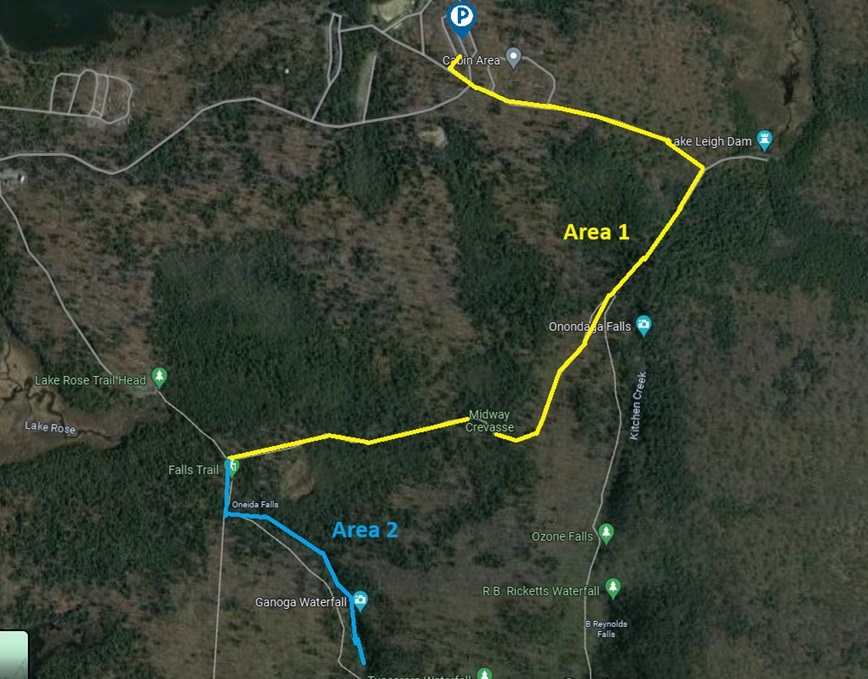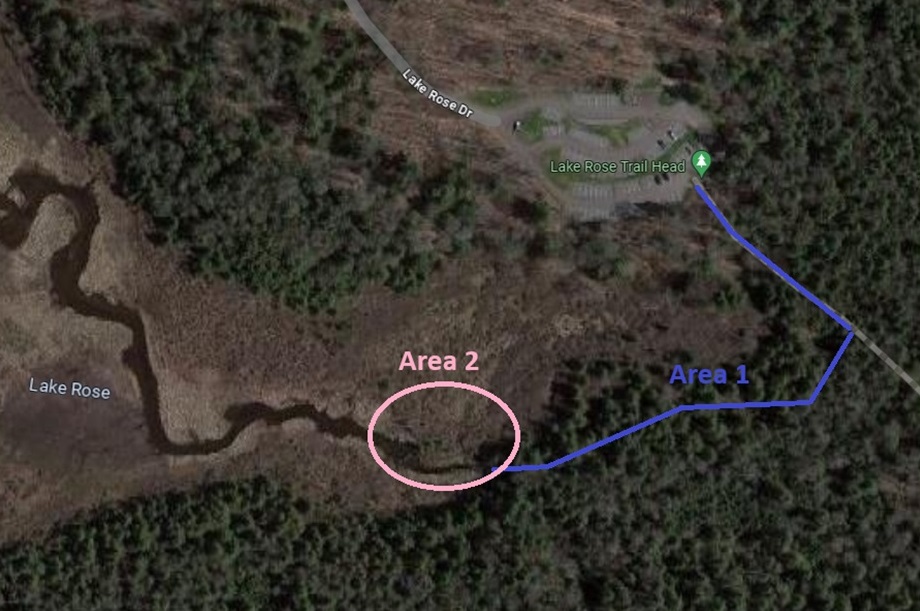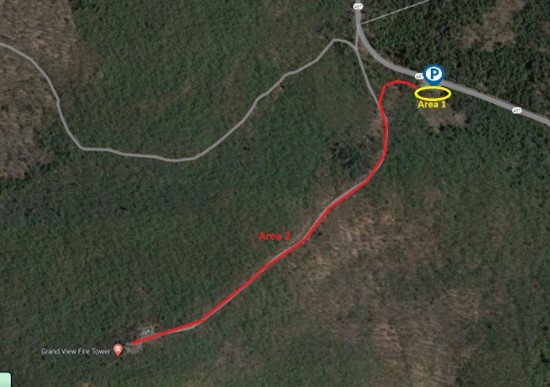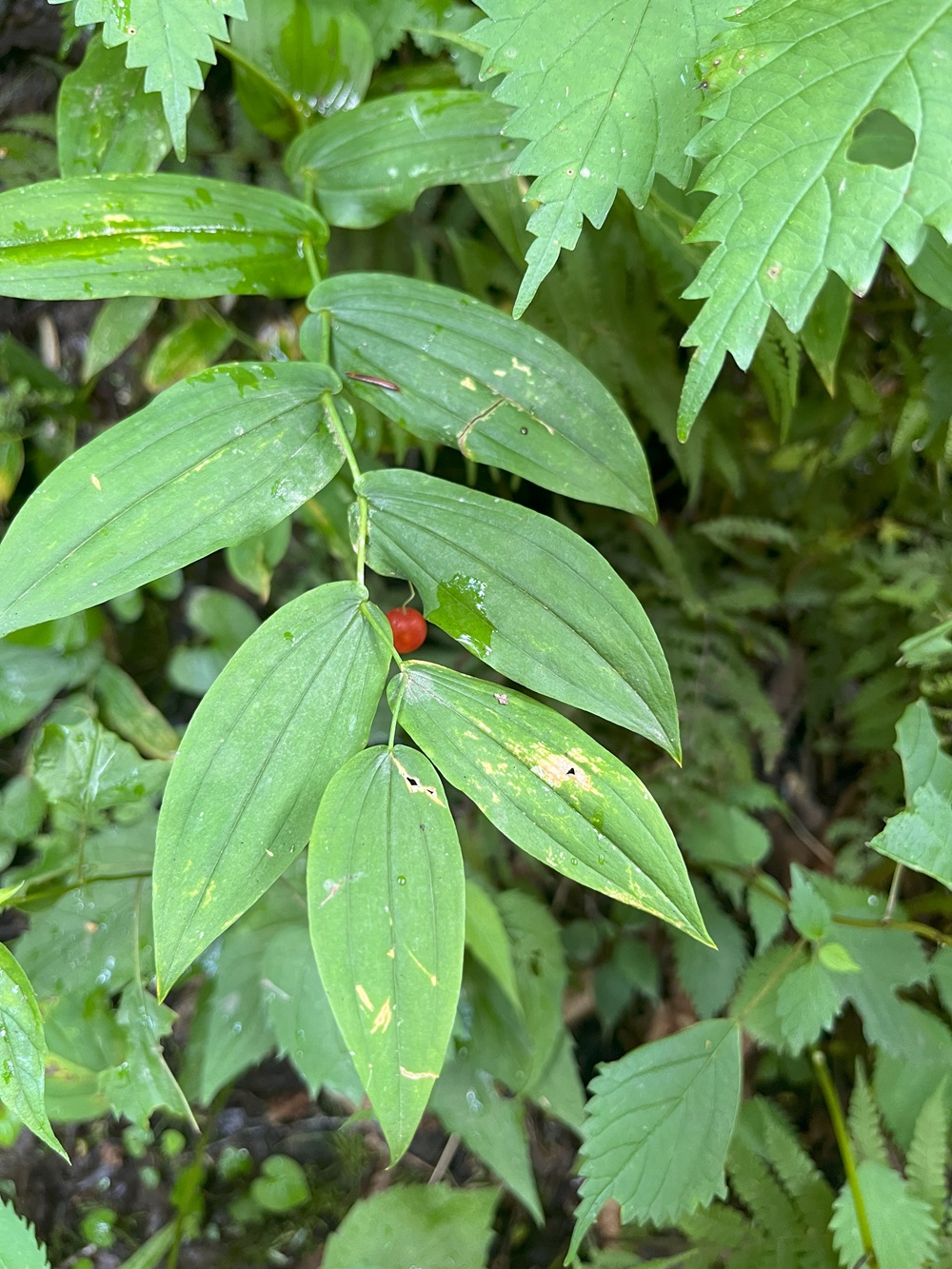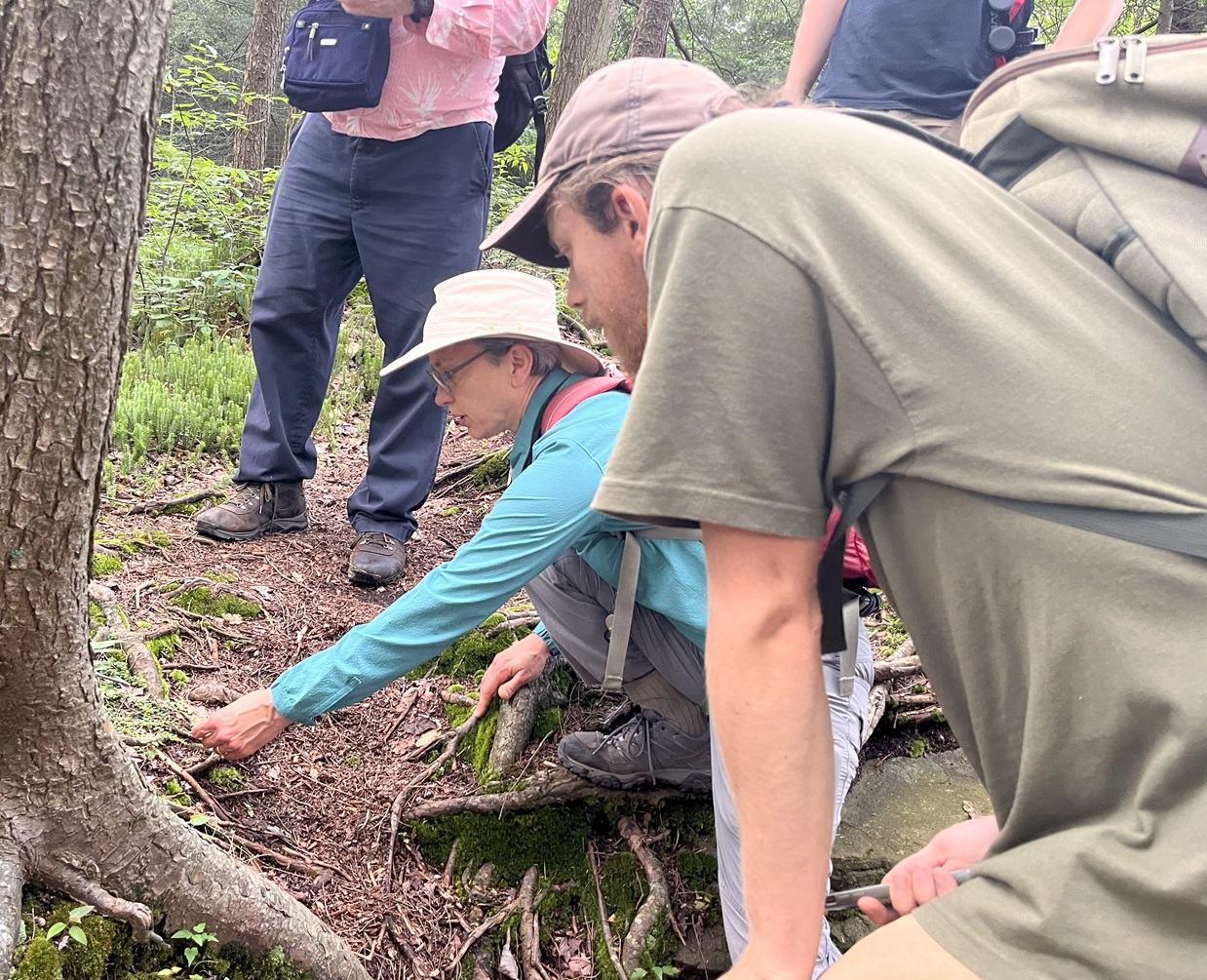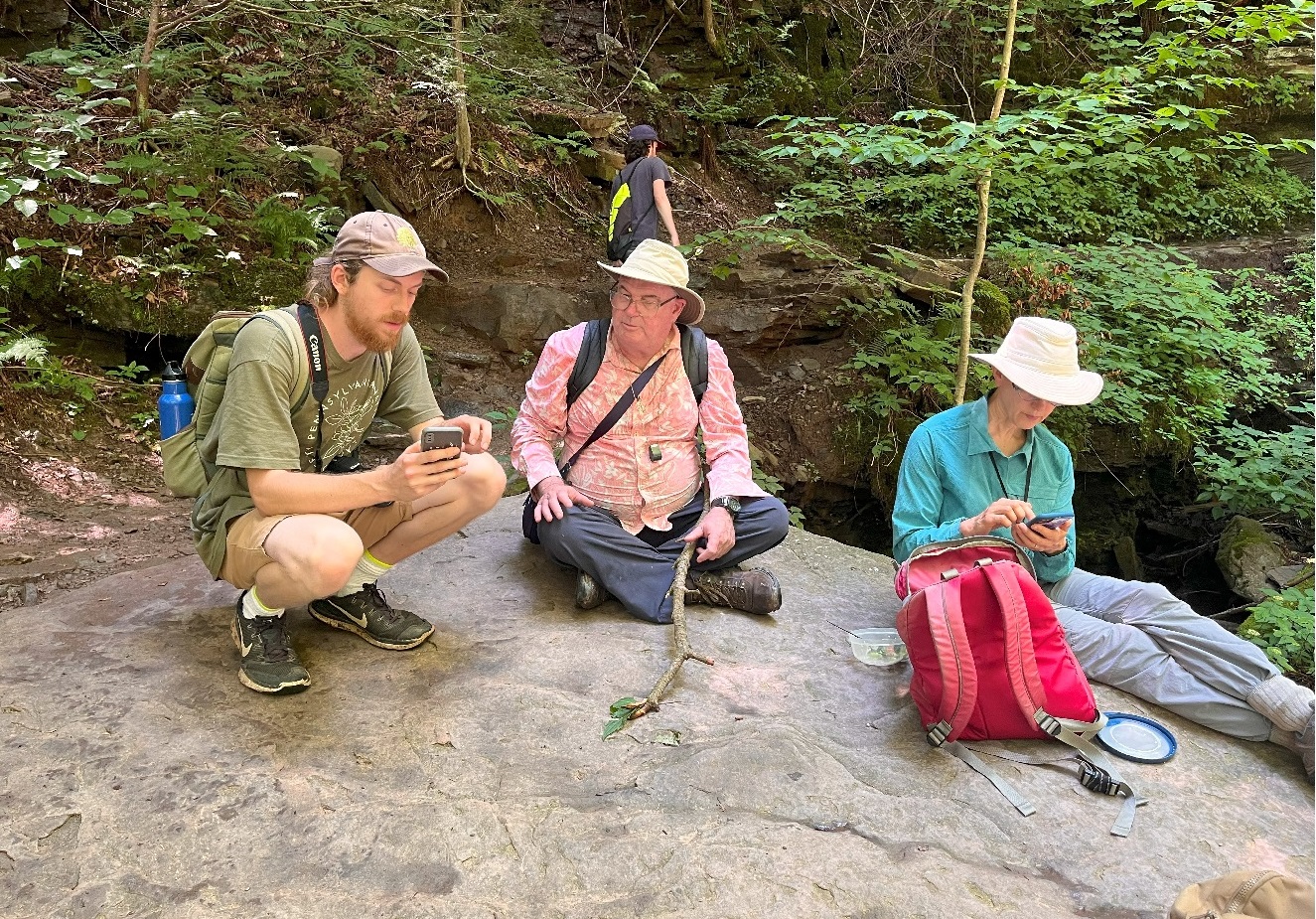Submitted by Andrew Conboy, Steve Jones, Janet Novak
Overview:
The Philadelphia Botanical Club’s trip to Ricketts Glen State Park took place on Saturday, July 13th and Sunday, July 14th. There were roughly twelve participants who joined the trip.
The park is one of the most scenic areas in Pennsylvania and is roughly 13,000 acres, spread through parts of Luzerne, Sullivan, and Columbia counties. It includes the Glens Natural Area, which is a National Natural Landmark, and is known for its many waterfalls. The 94-foot Ganoga Falls is the highest of 22 named waterfalls. Parts of the park contain true old growth trees with a diversity of shrubs, understory plants, and wildlife.
Beech Leaf Disease, putatively caused by the nematode Litylenchus crenatae mccannii, has infected nearly every beech tree in the areas we explored. Dense beech stands that normally cast a lot of shade have now thinned as their crowns die back, though only a few completely dead beeches were noted. The disease likely reached the park in 2021 or 2022, and has already caused significant damage. Hemlock decline from the Hemlock Woolly Adelgid (Adelges tsugae) was also noted, though young hemlock regeneration was common.
Before the formal start of the two-day trip, some members of the group surveyed the area.
A few members set up a light and sheet in an attempt to attract moths at night on Friday, July 12th, and Saturday, July 13th. Permission was granted by park staff to set up around the visitor center on July 13th. The results can be found by clicking on the links below:
One member explored the (artificial) Lake Jean shoreline just north of the trip’s starting point on the evening of Saturday July 13, and noted the presence of aquatic, emergent and wetland plants including Brasenia schreberi, Sagittaria latifolia, Pontederia cordata, Carex utriculata, and Spiraea alba.
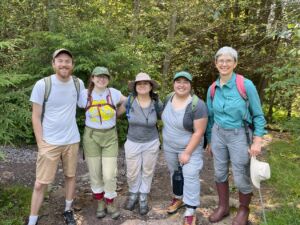
Routes and Maps:
Saturday:
On Saturday 7/13, we met at the park’s visitor center at 10 a.m. From there, we moved to Beach Lot #2 and took a trail east until we arrived at the Highland Trail. We took the Highland Trail west, through the Midway Crevasse and towards the Falls Trail (Area 1 on the map at the end of this report). Around the crevasse (labeled on map), we stopped to observe plants growing on the rocky outcroppings: Gaultheria hispidula (S3), Clintonia borealis, and Polypodium appalachianum.
Once at the Falls Trail, which is a steep but well-traveled trail along the west branch of Kitchen Creek, we hiked south to Ganoga Falls, the largest waterfall (Area 2 on the map at the end of this report). We spent some time here exploring the plants in the valley on the steep hills including Taxus canadensis, Hydrangea arborescens in bloom, Phegopteris connectilis, Chelone glabra, and Streptopus amplexifolius in fruit. Some ventured a bit further down to Mohican Falls, but eventually we all turned around and hiked the same way back up the trail.
This area is largely a Hemlock (white pine) – northern hardwood forest community, dominated mostly by Tsuga canadensis, Fagus grandifolia, Acer rubrum, and Betula alleghaniensis. Occasionally scattered were a few Tilia americana, Fraxinus sp., and Pinus strobus. Common woody understory plants included Acer pensylvanicum, Viburnum lantanoides, Acer spicatum, Vaccinium spp., Hydrangea arborescens, and Hamamelis virginiana. In an article on the site, the Pennsylvania DCNR notes that the significant diversity of tree species at the site relates to its location between the southern and northern hardwood forest types.
Sunday:
On Sunday 7/14, we met at the Shale Pit parking lot on the west side of PA 487 at 8:30am. From here, we moved to the Lake Rose Trail Head parking lot and hiked south along the trail, and then west into the woods towards Lake Rose to explore the bog here. In the moist woods along the way (Area 1 on map below), we found Trillium undulatum, Sorbus americana, Ilex montana, Coptis trifolia, Bazzania trilobata, Diphasiastrum digitatum, and Lysimachia borealis, among others. In the bog (Area 2 on map below), notable finds include: Lycopodiella inundata, Dulichium arundinaceum, Lysimachia terrestris, Eriophorum virginicum, Gentiana linearis, Drosera intermedia, and Betula populifolia.
Around 10:30am, we switched locations back to the Shale Pit parking lot, west of the Glens Natural Area. Around the parking lot (Area 1 on map below), we found Populus tremuloides, Robinia hispida in fruit, and a Larix that we assumed was non-native species based on the habitat. We came across an odd shrub that was later identified as Caragana arborescens, an exotic species and the first apparently-wild observation of it in PA on iNaturalist.
From here, we hiked the Laurel View Trail up to the fire tower (Area 2 on map below). These woods were of a different composition (probably Red oak – mixed hardwood forest) from what we observed in the Glens Natural Area, with Quercus rubra as the dominant tree. Other hardwoods noted included a few Castanea dentata resprouts, Sassafras albidum, Betula lenta, Betula alleghaniensis, Tsuga canadensis, and Pinus strobus. Understory plants included Kalmia latifolia, Kalmia angustifolia, Epigaea repens, Osmunda claytoniana, Melampyrum lineare, Gaultheria procumbens, and Rubus dalibarda. Some small treeless pockets along the way opened up more light for other meadow plants such as several patches of Asclepias syriaca, Comptonia peregrina, Anaphalis margaritacea, Apocynum cannabinum, Lysimachia quadrifolia, Erigeron strigosus, and Achillea millefolium complex.
Full Plant List:
Trees:
Fagus grandifolia
Acer rubrum
Tsuga canadensis
Acer spicatum
Tilia americana
Betula alleghaniensis
Betula populifolia
Acer pensylvanicum
Betula lenta
Castanea dentata
Pinus strobus
Sassafras albidum
Populus tremuloides
Larix sp.
Prunus pensylvanica
Liriodendron tulipifera
Magnolia acuminata
Fraxinus sp.
Amelanchier sp.
Shrubs:
Viburnum lantanoides
Viburnum acerifolium
Spiraea alba
Kalmia latifolia
Taxus canadensis
Hydrangea arborescens
Hamamelis virginiana
Comptonia peregrina
Robinia hispida
Kalmia angustifolia
Rubus idaeus
Vaccinium angustifolium
Vaccinium corymbosum
Ilex montana
Diervilla lonicera
Lonicera canadensis
Sorbus americana
Vaccinium spp.
Spiraea tomentosa
Gaylussacia baccata
Ferns:
Polypodium appalachianum
Dryopteris intermedia
Phegopteris connectilis
Osmundastrum cinnamomeum
Deparia acrostichoides
Cystopteris tenuis
Cystopteris sp.
Dennstaedtia punctilobula
Osmunda claytoniana
Onoclea sensibilis
Asplenium trichomanes
Pteridium aquilinum var. latiusculum
Others:
Scirpus cyperinus
Solidago altissima
Carex vulpinoidea
Carex crinita complex
Carex folliculata
Carex spp.
Geum canadense
Trillium undulatum
Dendrolycopodium obscurum
Huperzia lucidula
Viola rotundifolia
Oxalis montana
Maianthemum canadense
Oclemena acuminata
Mitchella repens
Hydrocotyle americana
Clintonia borealis
Gaultheria hispidula
Laportea canadensis
Arisaema triphyllum
Maianthemum racemosum
Eurybia divaricata
Tiarella stolonifera
Galium triflorum
Solidago flexicaulis
Eutrochium purpureum
Conocephalum salebrosum
Streptopus amplexifolius
Plagiomnium sp.
Chelone glabra
Lycopus americanus
Lycopus sp.
Artemisia vulgaris
Epipactis helleborine
Pontederia cordata
Solidago rugosa
Monotropa uniflora
Anaphalis margaritacea
Leucanthemum vulgare
Hypericum perforatum
Tussilago farfara
Apocynum cannabinum
Lythrum salicaria
Lobelia inflata
Melampyrum lineare
Gaultheria procumbens
Dianthus armeria
Uvularia sessilifolia
Erigeron strigosus
Rosa multiflora
Chimaphila maculata
Lysimachia quadrifolia
Epigaea repens
Eutrochium sp.
Aralia nudicaulis
Rubus dalibarda
Achillea millefolium complex
Lysimachia terrestris
Packera aurea
Viola sagittata
Dulichium arundinaceum
Asclepias syriaca
Rubus hispidus
Spinulum annotinum
Lysimachia borealis
Coptis trifolia
Diphasiastrum digitatum
Monarda didyma
Caulophyllum sp.
Actaea pachypoda
Pyrola elliptica
Chrysosplenium americanum
Polygonatum pubescens
Medeola virginiana
Prunella vulgaris
Gentiana linearis
Epilobium sp.
Lycopodium clavatum
Dichanthelium sp.
Dichanthelium acuminatum complex
Hypericum virginicum
Juncus sp.
Eriophorum virginicum
Drosera intermedia
Rhynchospora alba
Vaccinium macrocarpon
Lycopodiella inundata
Unsure:
Agrostis sp.

